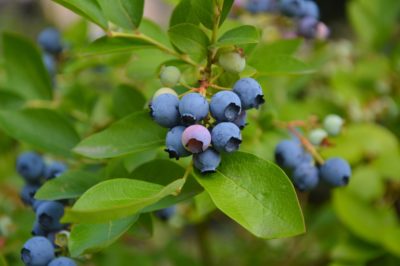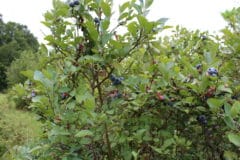About Highbush Blueberries
Highbush blueberries (Vaccinium corymbosum) are a good choice for your yard because they grow in more geographic areas than lowbush blueberries. These blueberries are the type of blueberries that grocery stores usually carry. They are native to eastern North America coastal regions, but according to the U.S. Highbush Blueberry Council, these blueberries grow across the U.S. and Canada.
- Resistant to pests
- Produce juicy, sweet, plump berries
- Grow in most of the U.S.
- Form attractive bell-shaped, white flowers
- Change to colorful, crimson leaves in the fall
Highbush Blueberry Bush Cultivars
The following list describes the various highbush cultivars you can choose for your yard. Depending on where you live, choose the variety that is hardy enough for your climate. For the best results, plant more than one cultivar for cross-pollination. This improves the berry size and fruit quality, as well as giving you a longer harvest time.
- USDA zone 6 to 7 – These highbush cultivars do well in the upper and middle south areas. The blueberries ripen from June to August. A few varieties include: Berkeley, Bluecrop, Bountiful Blue, Bluejay, Earliblue, Elliot, Libery, Patriot, Peach Sorbet and Top Hat.
- USDA zone 7 to 9 – These blueberry varieties grow in the middle, lower and coastal regions of southern U.S. Several of these cultivars include: Blue Ridge, Blue Suede, Emerald, Georgiagem, Sharpblue, Star, Summit, and Sunshine Blue.
- USDA zones 3 to 7 – The following highbush blueberry varieties are hardy enough for the cool, northern climates, especially in New England: Patriot, Bluecrop, Northland, Blueray, Meader, Jersey, Nelson, Blue Gold and St. Cloud.
Check with your local garden center to find other highbush cultivars that grow successfully in your area. Even hardy blueberries won’t grow if the temperature in your area drops below -20° (-28.8°C). You can work around cold conditions by planting your blueberries in an area protected by windbreaks, walls or fencing.
Choose a Sunny Location
Choose an area of your yard that gets at least eight hours of sunlight daily. If the blueberries grow in shady areas, the branches will be spindly and fruit production will decrease. Some bushes won’t bear any fruit, if they’re located in the shade.
Necessary Soil Conditions
After selecting a sunny location for your blueberry bushes, make sure the soil is fertile, acidic, well-drained and has plenty of organic matter. You can do a home soil test to find out the acidity of your soil and make adjustments that meet the blueberry growth requirements. The soil should have a pH of 4.5 to 5.6. If it’s higher than this, add powdered sulfur to the soil. If your soil tests lower than the required pH, add limestone to raise the pH.
Blueberries feast on organic matter, so once you adjust the pH of the soil, add organic material, such as compost, leaves, straw or peat moss. Another method of adding organic matter to the soil is to plant a green manure crop in the fall or early spring. This crop includes buckwheat, winter rye, ryegrass or soybean. Just till the grain into the soil before it reaches maturity.
How to Plant Highbush Blueberries
Plant blueberry bushes that are one or two years old. The best time to plant young bushes is in the spring. If you’re planting rooted cuttings, it will add two more years before the bushes bear fruit. Follow these steps for planting your blueberry bushes:
- Dig a hole deep enough to hold the roots of the bush.
- Spread the roots around inside the hole.
- Fill in the hole with a blend of soil and compost.
- Avoid any type of fertilizer because it will burn the roots.
- Water the plants thoroughly after planting.
- Prune any broken branches.
If you’re planting more than one blueberry bush, space them 2 to 6 feet apart. Rows of bushes should also be 2 to 6 feet apart, depending on the variety you chose and how big it is when fully grown. Weed between the rows and water frequently. When flowers bloom during the first year, rub them off the branches to help establish the bush.
Second Season
During the spring of the second year of growth, spread about 4 to 8 inches of mulch around your blueberry bushes. You can use wood chips or back but avoid sawdust. Plant ground cover between the rows of bushes. A few suitable ground covers are bluegrass or hard fescue. Mow it a couple of times during the year.
Young blueberry bushes don’t need fertilizer. They get all the nutrients they need from the soil. In fact, over fertilizing causes weed growth and winter injuries to the bushes.
Prune any dead or broken branches to encourage new growth. Once again, remove any flowers during the second year. Do your pruning in the winter, while the blueberry bush is still dormant. Trim off any branches growing close to the ground, since this encourages the plant to grow upright.
Three Years and Over
After the first three years, your blueberry bushes grow from six to 12 branches or canes coming up from the ground. Trim off any weak-looking shoots or old, gray-brown stems, leaving no more than 12. The shoots that are three to six years old produce the most berries. With the proper care, your bushes will produce blueberries for 40 years.
Harvesting Blueberries
It’s seems like a long wait between the time you planted your first blueberry bushes until the time to harvest, but it’s worth the wait. Most blueberries are ready for harvesting from late July to the middle of August. Some cultivars have berries until the first frost arrives. If you planted early, mid-season and late-season varieties, you’ll can have blueberries from July to October.
Pick the berries when they’re completely blue. Green blueberries are sour. Store your blueberries in the refrigerator to prevent deterioration. The best temperature for storing blueberries is 32°F (0°C).












